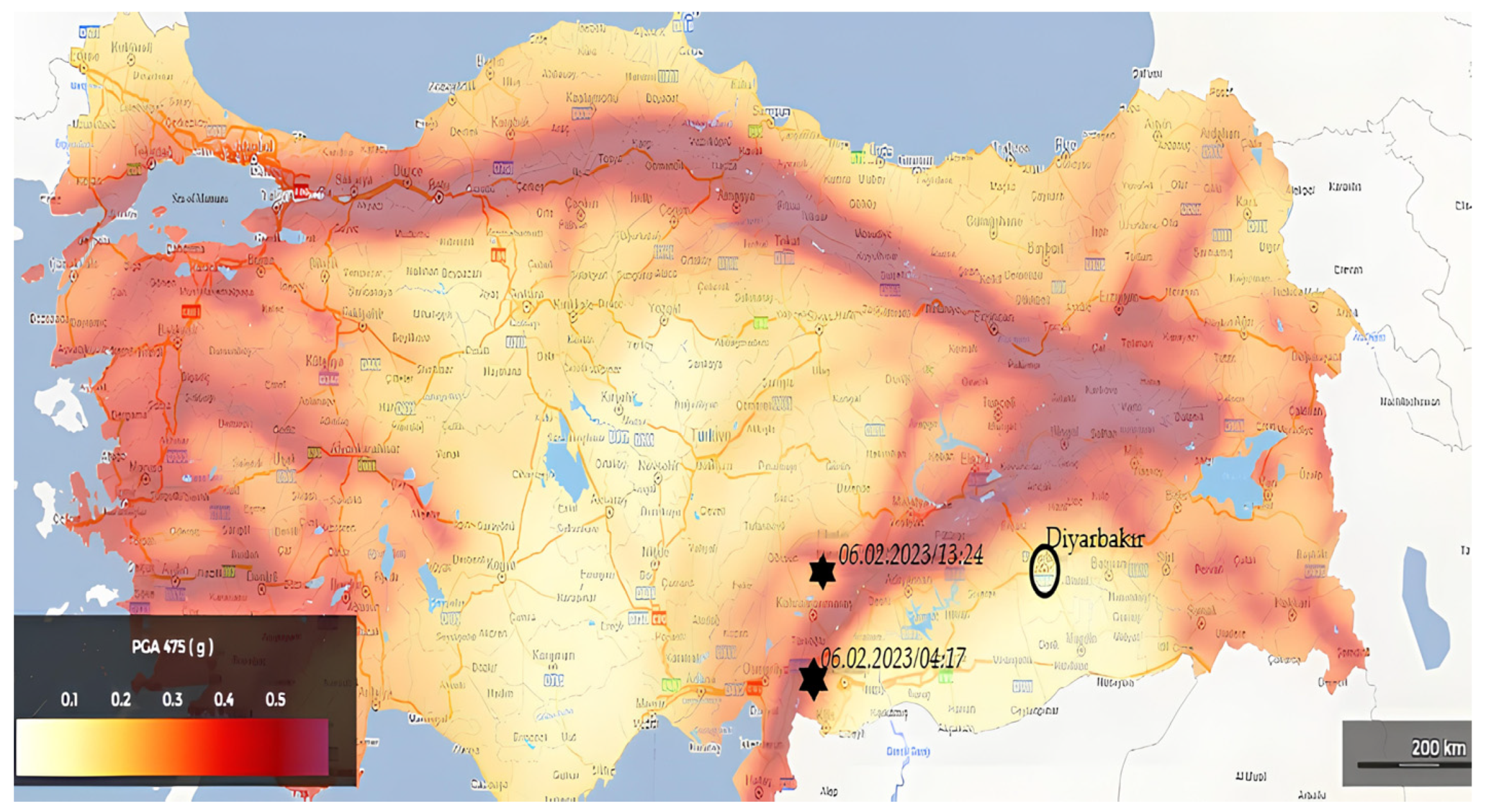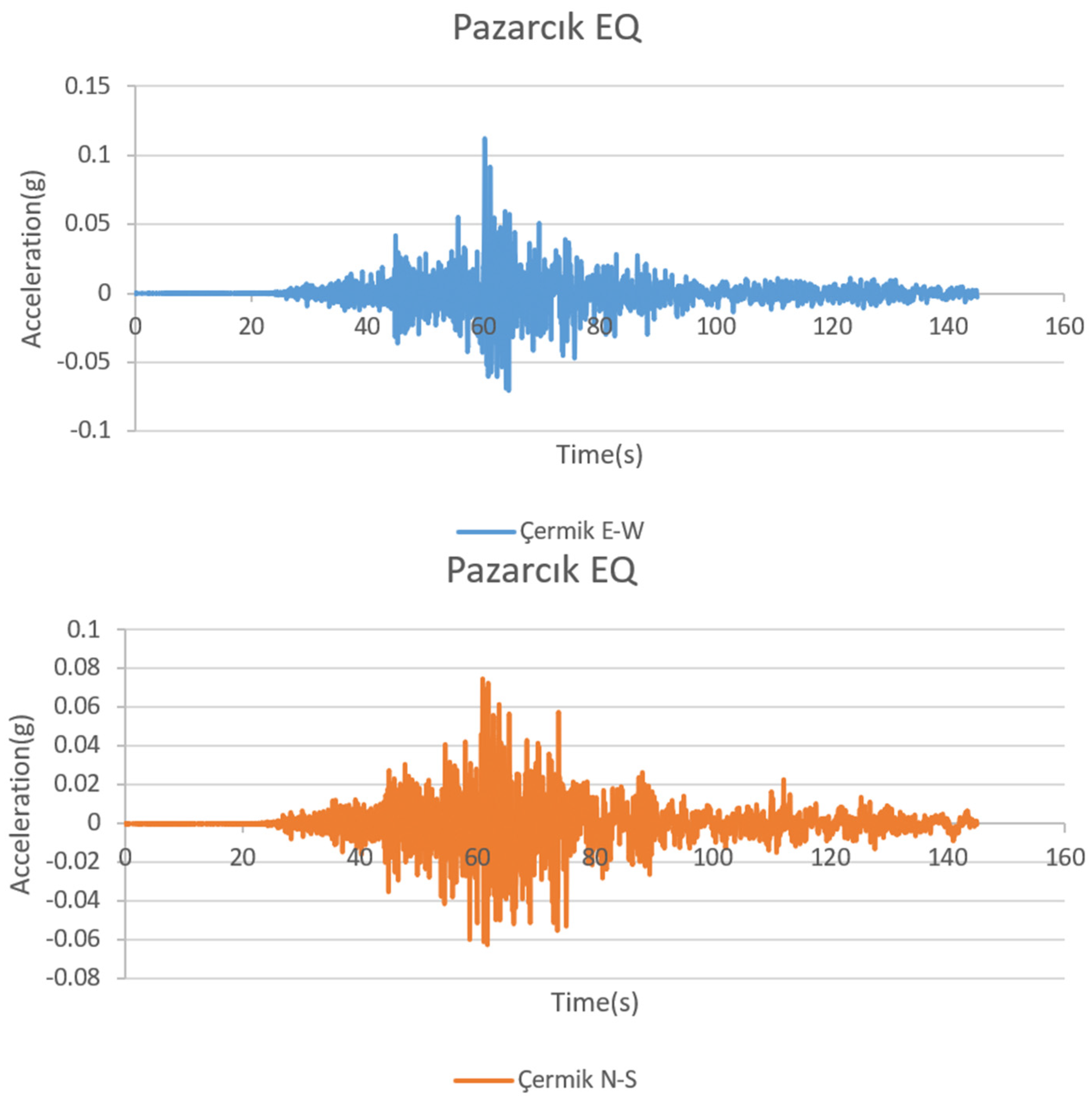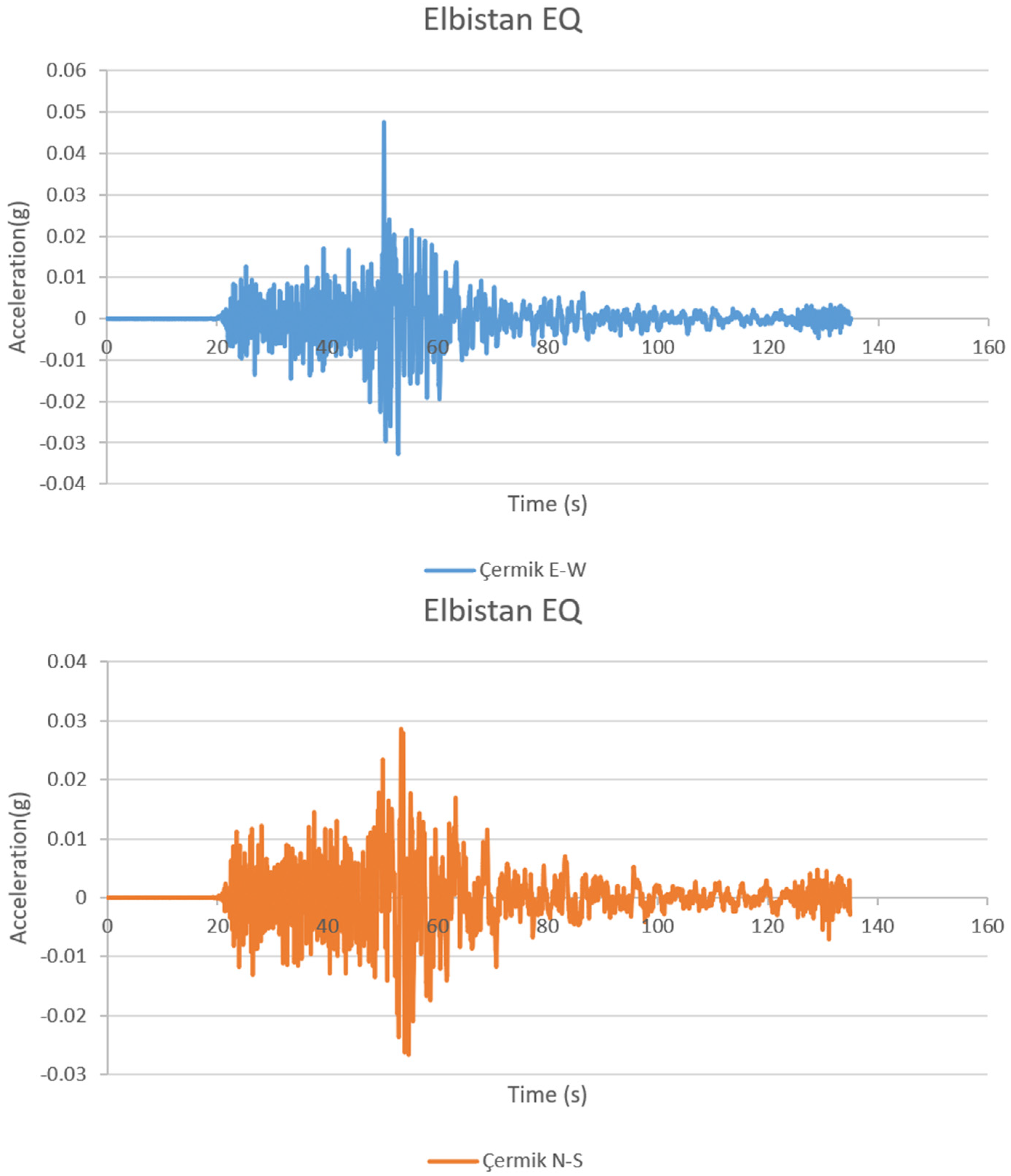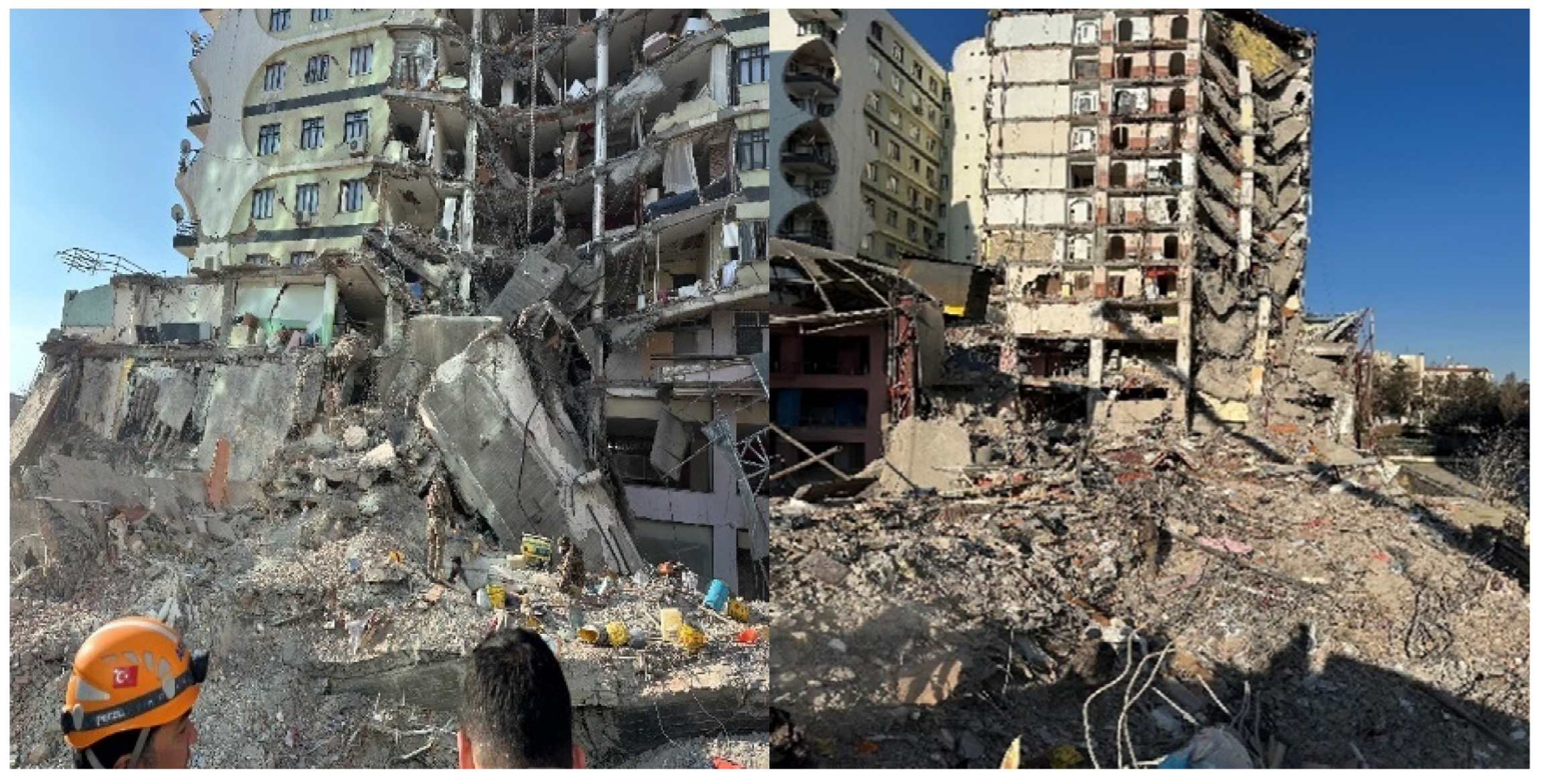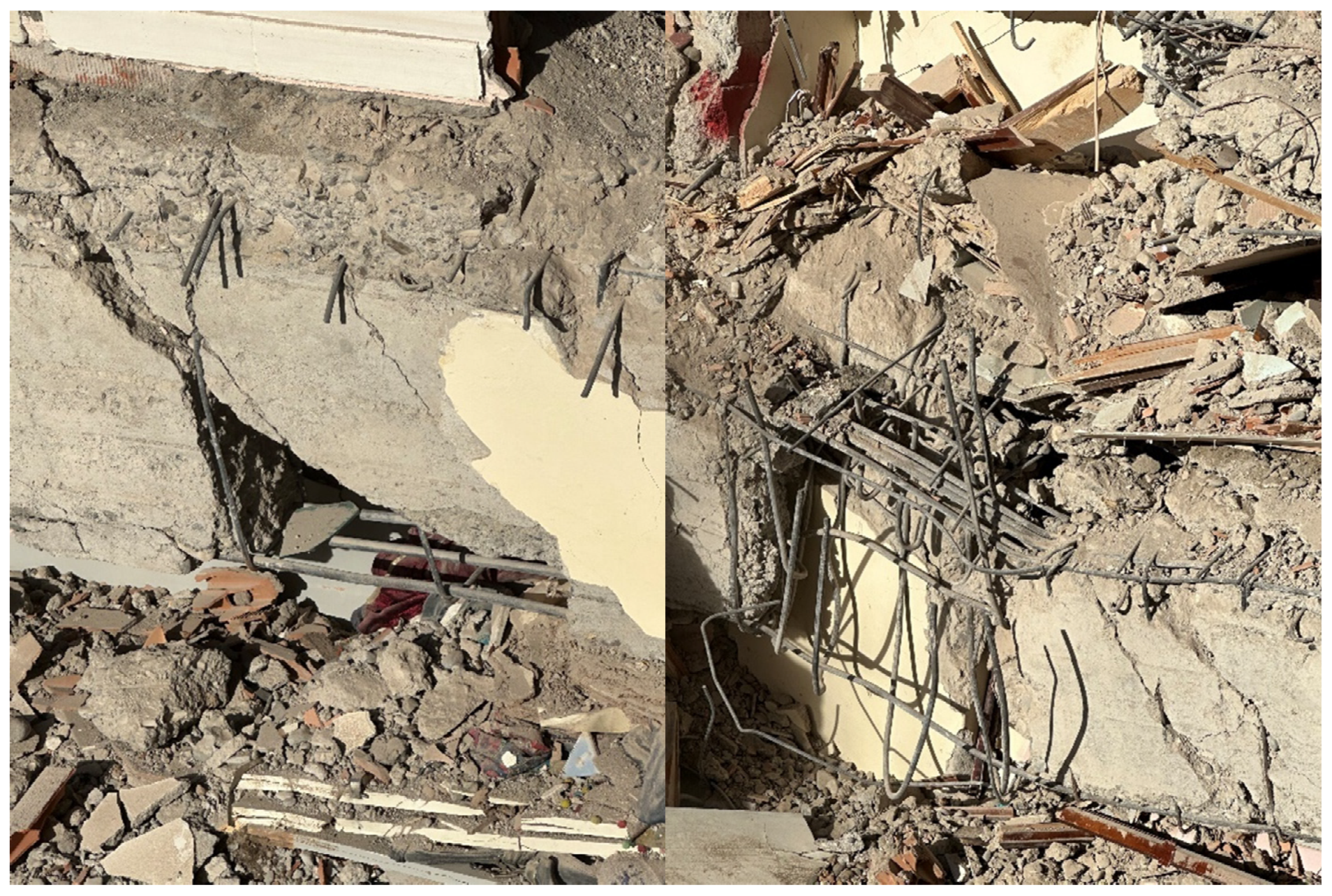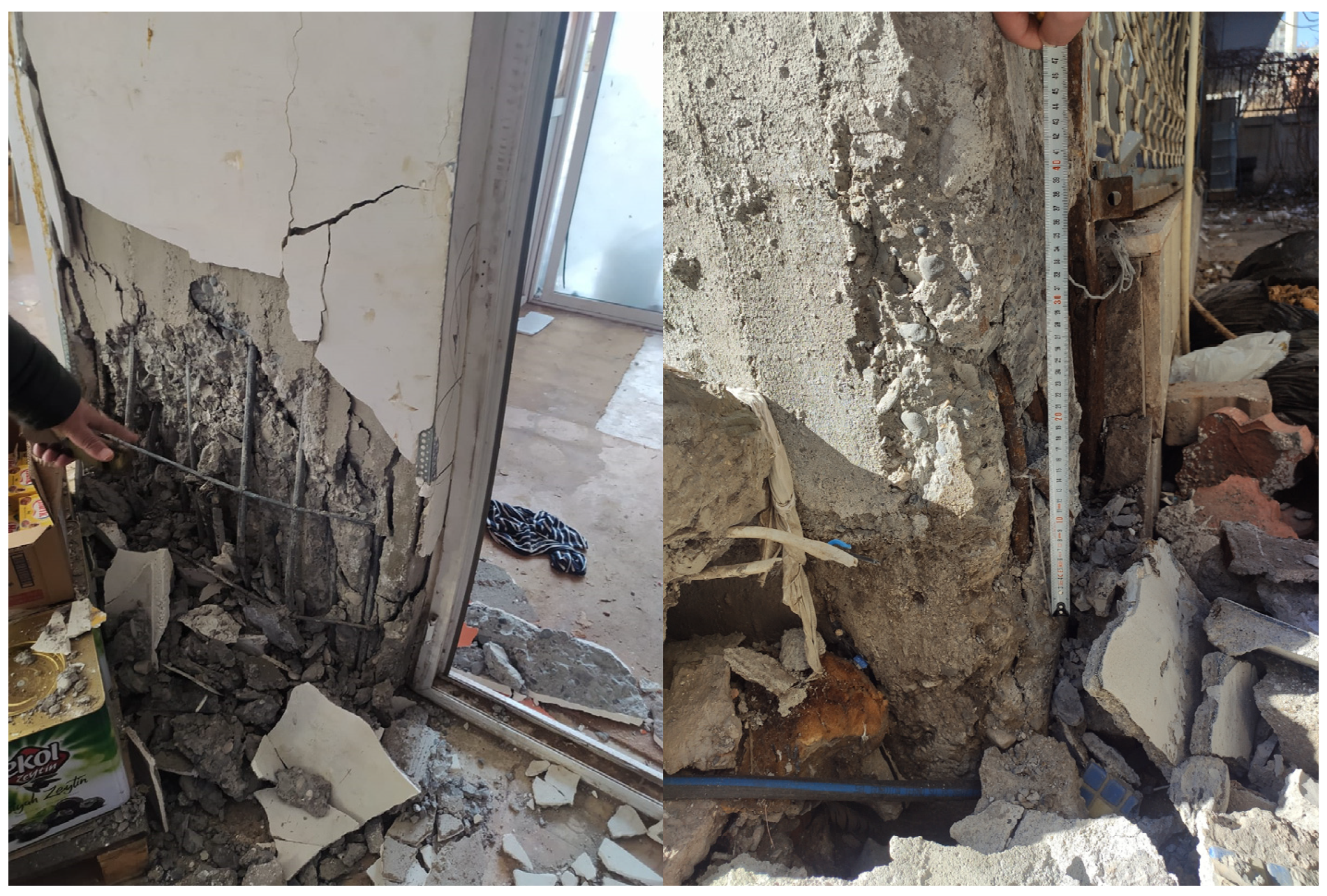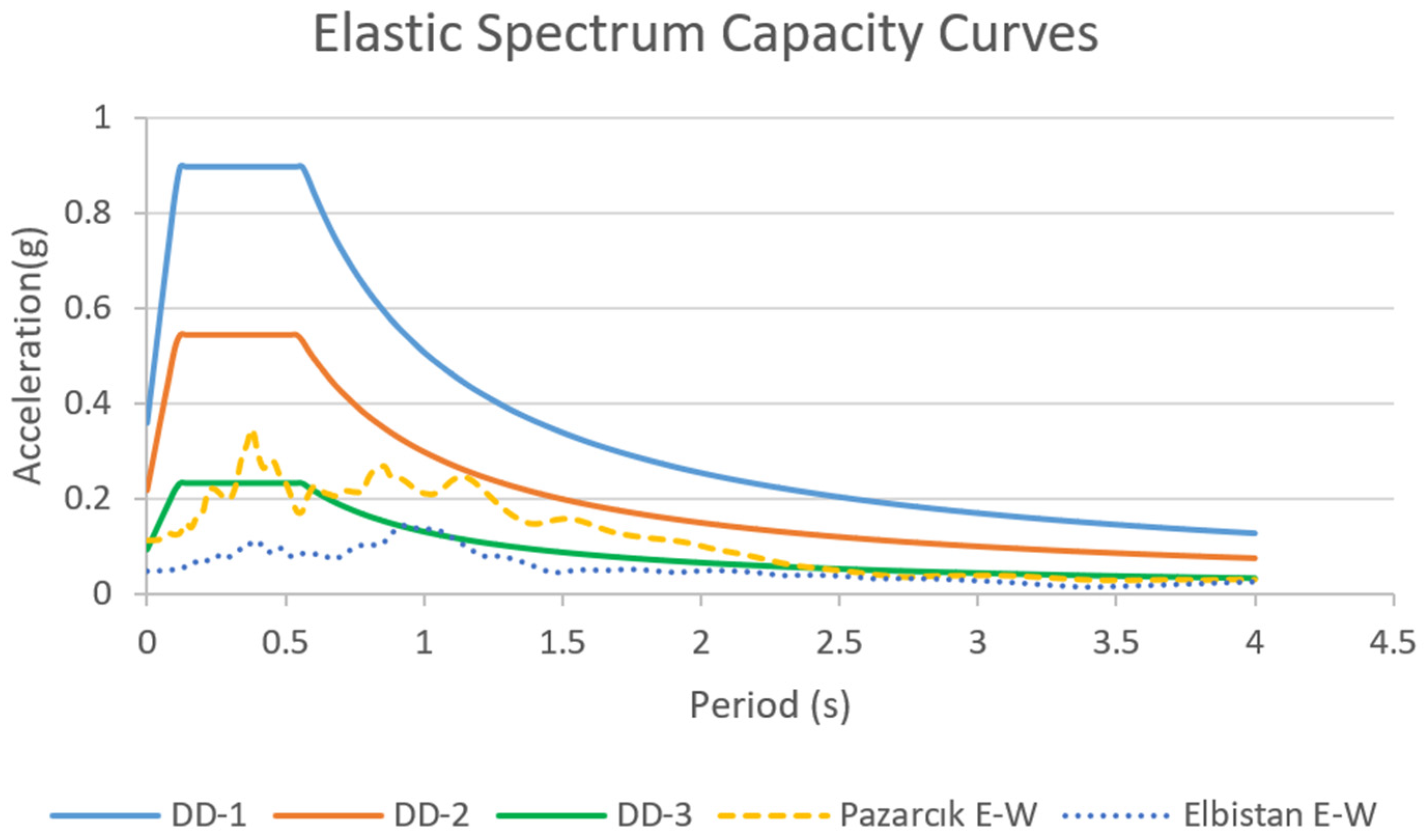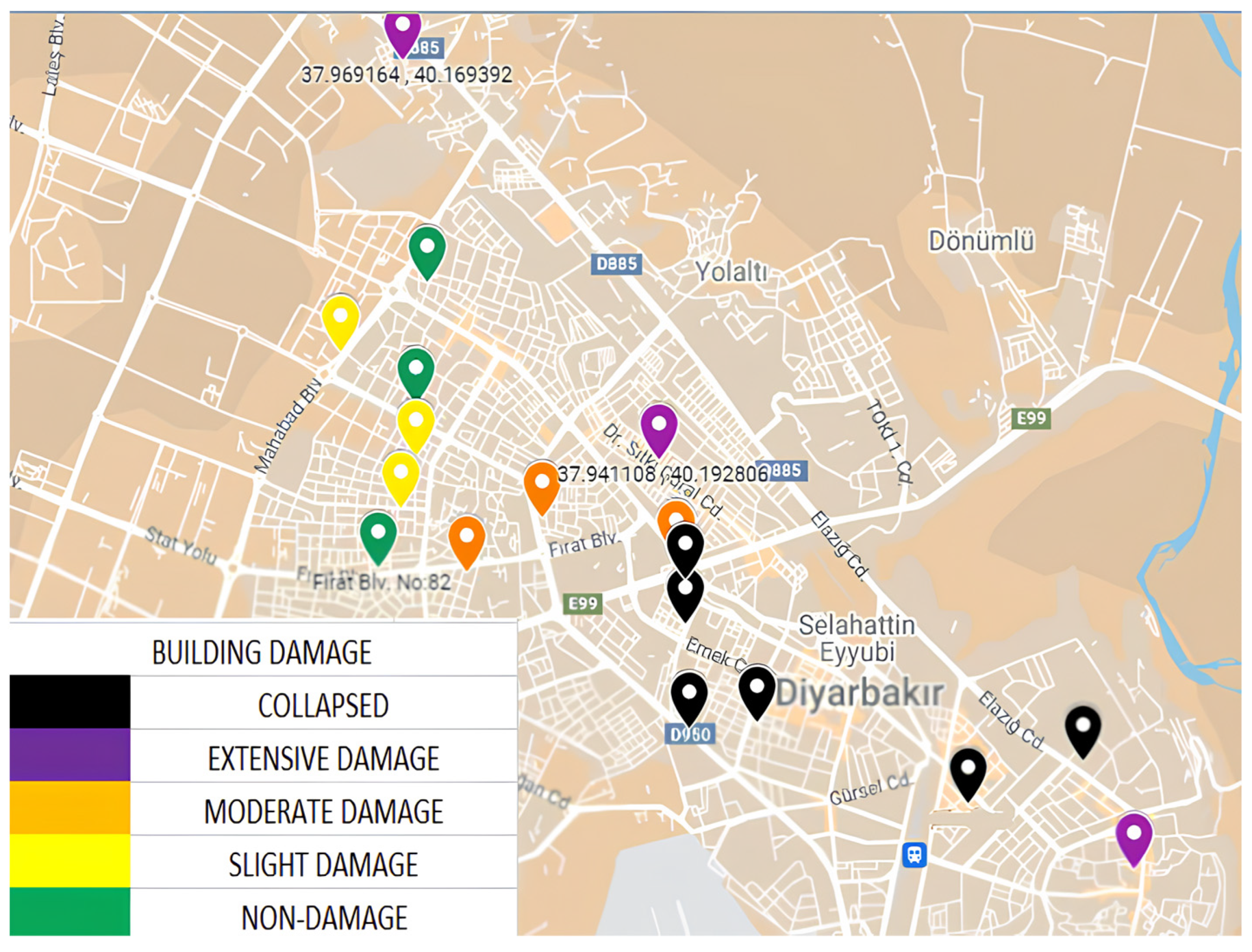The location data of the earthquakes with respect to the Bogazici University Kandilli Observatory and Earthquake Monitoring Center (KOERI) [
27], Geofon Data Center (GFZ) [
28], Disaster and Emergency Management Presidency, Republic of Türkiye (AFAD) [
29] and United States Geological Survey (USGS) [
30] are shown in
Figure 1. On the other hand, the current earthquake hazard map of Türkiye and the location of Diyarbakır province’s Türkiye Earthquake Hazard Maps Interactive Web Application (TEHMIWA) [
29] is given in
Figure 2.
During the Elbistan earthquake, the Göksun station (coded 4612 (R
epi = 66.68)) recorded the highest acceleration value of 0.63 g in the north–south direction. Meanwhile, the Çermik station (R
epi = 198.48) in Diyarbakır recorded the highest value of 0.047 g in the east–west direction. These values are given in
Table 2 and
Table 3 for both earthquakes.
Figure 4 and
Figure 5 show the accelerations and spectra obtained with the data of station 2107 in Diyarbakır province for both the Pazarcık and Elbistan earthquakes. Since the maximum intensities are in the N–S direction, the PGV, Arias and Houser intensities are only given in the N–S direction.
It is noted that, based on the earthquake intensities and acceleration records taken into consideration for Diyarbakir province, there may be some moderate damage resulting from the relatively long duration of the earthquake. Past earthquakes have demonstrated that numerous factors, including earthquake duration, near-fault and far-fault effects [
32] and soil–structure interaction, can significantly impact earthquake damage. However, in the specific case of Diyarbakır, the distance from the earthquake’s epicentre and the relatively lower values of the measured earthquake parameters (such as Arias and Houser intensities and PGA and PGV values) than the obtained values from the EQ epicentre indicate the severity of the structural damage observed. However, because of substandard dwelling construction aspects, the structural damage and loss of lives resulting from these earthquakes extended to unacceptable levels.
2.1. Investigation of the Collapsed Buildings in Diyarbakır
Earthquake amplitudes decrease in parallel with the distance–decay relationship as one moves away from the earthquake focal point, and accordingly, lower values were expected to be observed in Diyarbakır. However, the unexpected disproportionate destruction, damage and loss of lives in response to these low acceleration values raise some questions. In the observations made in the field after the earthquake, the presence of many structural defects, especially low-strength concrete and poor steel reinforcement, are noteworthy. In Diyarbakır province, the locations of a total of 18 buildings, including the building shown in
Figure 6,
Figure 7 and
Figure 8, 5 other collapsed buildings, 9 damaged (slightly, moderately and extensively damaged) buildings and 3 undamaged buildings, were marked with the help of the GPS on-site detection.
Figure 8 shows the undamaged ground floor columns of the completely collapsed building. The slender column rising after the column with an exceptionally large cross-section might indicate that this building was subjected to an insufficient retrofitting process. Some damage examples of inappropriate shear walls and columns are illustrated in
Figure 9 and
Figure 10.
According to the official Provincial Damage Assessment Reports, the numbers of the extensively damaged or collapsed, moderately damaged and slightly damaged buildings were recorded as 8602, 11,209 and 113,223, respectively, with hundreds of casualties [
33]. The common cause of the collapse of the mentioned collapsed or extensive damaged structures can be considered according to many constructional defects, especially low concrete strength.
2.2. Structural Analyses
Local seismic parameters were obtained with the help of the Türkiye Earthquake Hazard Map created by TBEC2018 [
34] with micro zonation. Previous regulation TSC-2007 [
35] considered the local seismic parameters constant due to the regional approach. In order to compare these parameters, a sample reinforced concrete structure was modelled in SeismoStruct v.2023 software in accordance with the current regulations. Using pushover analysis, the damage limit values determined in Eurocode 8 [
36] were obtained and compared for different PGA values of the investigated structure.
The analysis steps of pushover analysis as a performance-based evaluation method that estimates the structural responses to seismic loads by applying a series of increasing lateral loads are shown in
Figure 11. The method is particularly useful in identifying the weak points and failure mechanisms of structures and helps in determining appropriate retrofitting strategies [
37,
38,
39].
The initial step involves assuming a particular pattern for the lateral load, followed by conducting a static analysis of the structural model under this load pattern in a pushover analysis. A distributed load pattern has been used with a 0.3 m target displacement in this study. The evaluation of the earthquake impact and the devastating effects on buildings can be performed not only by extracting its various peaks and cumulative parameters but also by calculating various types of linear and nonlinear seismic spectra. Furthermore, pushover analysis can be performed for various simplified cases of buildings in an effort to estimate the response that they would exhibit during the earthquake. The calculated parameters can provide some hints about the destructiveness of the earthquake and how the buildings could be designed to be able to resist such earthquakes in the future [
40].
In the present study, the seismic parameters of the earthquakes are calculated to provide explanations about the large unexpected structural destructiveness in Diyarbakir. Structural analysis of a reinforced concrete building in Diyarbakır was performed using both the measured and current acceleration values according to the last two earthquake hazard maps. The results of this analysis reveal significant differences between the expected target structural displacement values, highlighting the importance of continuous updates to these maps for accurate seismic risk assessment.
For a comprehensive understanding of the Pazarcık Earthquake’s impact on Diyarbakır, earthquake-damaged and collapsed buildings in the province were analysed. Three buildings, each with minor, moderate, and severe damage, and six buildings that collapsed during the earthquake were selected for this purpose. The sample building’s 2D view, 3D view, and blueprint of the sample RC model can be seen in
Figure 12. The numerical specifications of the sample building are given in
Table 4. The fundamental period of the structure was 0.8271 s; the maximum base shear was 6557.27 kN; the elastic stiffness K_elas and the effective stiffness K-eff were obtained as 120,492.20 kN/m and 63,600.91 kN/m, respectively.
The latest version of the Turkish Building Earthquake Code (TBEC-2018) has introduced three additional levels of ground motion (DD-1, DD-3, DD-4) compared to the previous edition. In the previous code, only the standard earthquake ground motion level with a recurrence period of 475 years and a 10% probability of exceedance in 50 years (DD-2) was considered in TSC-2007. It is important to note that the first two levels (DD-1 and DD-2) of the four earthquake levels correspond to the design earthquakes in ASCE-07 [
41]. The current code outlines four different levels of ground motion, which can be found in
Table 5.
TEHMIWA is a user-friendly and practical web application designed for use by the Disaster and Emergency Management Agency of Türkiye (AFAD). It enables the calculations of earthquake parameters for any location using various earthquake ground motion levels, local ground conditions, and latitude and longitude data. The application takes into account the probability of exceedance and local ground conditions to obtain the short-period map spectral acceleration coefficient (S
S) and the map spectral acceleration coefficient (S
1) for the 1 s period. The design spectral acceleration coefficients S
DS and S
D1 are determined using equations that consider the spectral acceleration coefficients (S
S and S
1) and local ground coefficients (F
S, F
1).
Table 6 and
Table 7 provide the local ground effect coefficients for the short period (F
S) and 1.0 s (F
1), respectively. These coefficients are being used for the first time in the current code, with greater emphasis on the local ground effect.
To allow for accurate comparisons, ZC was selected as the standard soil class based on TBEC-2018. This soil class will remain consistent for all parameters requiring a local soil class, and its characteristics can be found in
Table 8.
The spectral acceleration coefficients are only compared for the DD-2 ground motion level. This is because the previous code only used ground motion levels with a recurrence period of 475 years and a 10% probability of exceedance in 50 years.
Table 9 shows the comparison of the spectral acceleration coefficients based on the last two seismic design codes. There were no vertical values in the previous code, so no comparisons were made in that direction.
Damage limits, which represent the point at which a structure can no longer withstand applied loads, play a crucial role in assessing the performance of buildings during earthquakes. In the case of the Pazarcık Earthquake, an evaluation was conducted to determine the damage limits of the selected buildings in Diyarbakır. This assessment provided valuable information regarding the responses of local structures to the seismic activities and the extent of the damage they sustained.
The limit states given in Eurocode 8, which is used worldwide for damage estimation, were also taken into consideration in the study. Detailed descriptions of these limit states are given in
Table 10.
The local seismic parameters of these selected buildings were analysed according to the 2018 Building Earthquake Code of Türkiye. This analysis revealed significant differences between the expected target structural displacement values resulting from the structural analysis.
The seismic values of the Pazarcık and Elbistan earthquakes were compared with the current peak ground acceleration values specified in the current Turkish Earthquake Design Regulation. This comparison demonstrated differences between the measured and proposed peak ground accelerations for some earthquakes.
These data are from TBEC (2018) (Turkish Earthquake Building Code). DD1 is 2% in 50-year ground motion level. A comparison with DD2, i.e., 10% in 50-year ground motion level, is given in
Figure 13.

